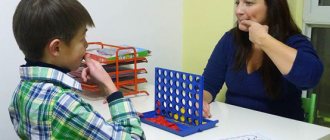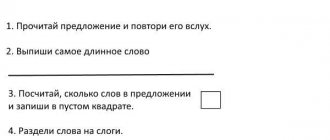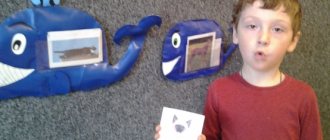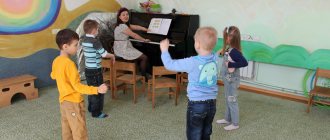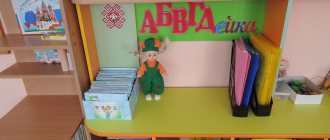Types of speech development activities
Depending on the leading task, the main program content of the lesson:
· classes on the formation of a dictionary (inspection of the premises, familiarization with the properties and qualities of objects);
· classes on the formation of the grammatical structure of speech (didactic game “Guess what is missing” - the formation of plural nouns of the gender case);
· classes on developing the sound culture of speech (teaching correct sound pronunciation);
· classes on teaching coherent speech (conversations, all types of storytelling),
· classes on developing the ability to analyze speech (preparation for learning to read and write),
· classes on familiarization with fiction.
Depending on the use of visual material:
· classes in which objects of real life are used, observations of phenomena of reality (examination of objects, observations of animals and plants, excursions);
· classes using visual aids: with toys (looking at, talking about toys), pictures (conversations, storytelling, didactic games);
· activities of a verbal nature, without relying on clarity (general conversations, artistic reading and storytelling, retelling, word games).
Depending on the stage of training, i.e. depending on whether a speech skill (skill) is being formed for the first time or is being consolidated and automated.
Close to this is the classification according to didactic purposes (based on the type of school lessons) proposed by A. M. Borodich:
· classes on communicating new material;
· classes to consolidate knowledge, skills and abilities;
· classes on generalization and systematization of knowledge;
· final, or accounting and verification, classes;
· combined classes (mixed, combined).
Speech development methods
Method is a way of activity of the teacher and children, ensuring the formation of speech skills and abilities.
There are three groups of methods - visual, verbal and practical.
Visual methods. Both direct and indirect methods are used. To immediate
refers to the observation method and its varieties: excursions, inspections of the premises, examination of natural objects. These methods are aimed at accumulating the content of speech and providing communication between two signaling systems.
Indirect methods
based on the use of visual clarity. This is looking at toys, paintings, photographs, describing paintings and toys, telling stories about toys and paintings. They are used to consolidate knowledge, vocabulary, develop the generalizing function of words, and teach coherent speech. Indirect methods can also be used to get acquainted with objects and phenomena that cannot be encountered directly.
Verbal methods are used less frequently in kindergarten: reading and storytelling of works of art, memorization, retelling, general conversation, storytelling without relying on visual material. All verbal methods use visual techniques: showing objects, toys, paintings, looking at illustrations, since the age characteristics of young children and the nature of the word itself require visualization.
Practical methods are aimed at using speech skills and abilities and improving them. Practical methods include various didactic games, dramatization games, dramatizations, didactic exercises, plastic sketches, and round dance games. They are used to solve all speech problems.
Additional:
Reproductive methods are based on reproducing speech material and ready-made samples.
Productive methods involve children constructing their own coherent utterances, when the child does not simply reproduce the language units known to him, but selects and combines them in a new way each time, adapting to the communication situation.
Speech development techniques
Verbal techniques . These include speech pattern, repeated speaking, explanation, instructions, assessment of children's speech, question.
Visual techniques - showing illustrative material, showing the position of the organs of articulation when teaching correct sound pronunciation
Game techniques can be verbal and visual. They arouse the child’s interest in activities, enrich the motives of speech, create a positive emotional background of the learning process and thereby increase children’s speech activity and the effectiveness of classes. Gaming techniques meet the age characteristics of children and therefore occupy an important place in native language classes in kindergarten.
Vocabulary development methodology
Vocabulary work is a purposeful pedagogical activity that ensures effective development of the vocabulary of the native language. Vocabulary development is a long-term process of quantitative accumulation of words, mastering their socially assigned meanings and developing the ability to use them in specific communication conditions.
Tasks:
1. enriching the vocabulary with new words, children learning previously unknown words, as well as new meanings for a number of words already in their vocabulary. The enrichment of the dictionary occurs, first of all, due to commonly used vocabulary (names of objects, characteristics and qualities, actions, processes, etc.).
2. consolidation and clarification of vocabulary.
3. activation of the dictionary.
4. elimination of non-literary words (dialectal, colloquial, slang) from children’s speech.
Two groups of methods can be distinguished: methods of accumulating the content of children's speech (methods of familiarization with the world around them and enriching the vocabulary) and methods aimed at consolidating and activating the vocabulary, developing its semantic side.
The first group includes methods: a) direct familiarization with the environment and enrichment of vocabulary: examination and examination of objects, observation, inspections of the kindergarten premises, targeted walks and excursions; b) indirect acquaintance with the environment and enrichment of the vocabulary: viewing paintings with unfamiliar content, reading works of art, showing films, films and videos, watching television programs.
1. Children of primary preschool age master the specific content of the words they need for communication and denoting objects in their immediate environment, parts of objects, and actions with them. A significant feature of the speech of children of this age is the distortion of the sound and morphological structure of word names: instead of shell they pronounce “shell”, “rakinawa”; instead of a soap dish - “soap”, “soap”.
In junior groups, two types of classes are held: 1) for initial familiarization with subjects, 2) for deepening knowledge about subjects.
2. Middle preschool age is a qualitatively new stage in the development of a child. At this stage, the vocabulary is further enriched and the ability to generalize develops. This is due to the expansion of the child’s life experience and his circle of communication with adults and other children. In the middle group, the same didactic games are carried out, but the material for them is selected in accordance with the vocabulary of the children. The number of objects (pictures) and their characteristics that stand out in the game is increasing. Games “Guess what they hid”, “Look and remember”, “Guess what has been added”, “Wonderful bag”, “Guess what has changed”.
3. A child of senior preschool age differs significantly from a child 4–5 years old. The most important thing is that his personality as a whole develops, his consciousness grows and develops. The child begins to think on the basis of general ideas, his attention becomes more focused and stable. The range of interests is expanding, activities are improving. On this basis, there is a further expansion and deepening of the range of ideas and growth of the vocabulary. Children aged 5–7 years speak everyday vocabulary at the level of the spoken language of adults. In the older group, it is necessary to expand the vocabulary through the names of objects, qualities, actions; activate the dictionary; learn to use the words that are most appropriate in meaning when denoting the characteristics and qualities of objects; develop the ability to select words with opposite meanings
What reasons influence the appearance of speech problems?
Psychologists say that preschool children entering school often have speech problems that prevent them from learning successfully. The most serious of them are:
- monosyllabicity and inexpressiveness of speech constructed from elementary sentences;
- stinginess of vocabulary;
- the use of slang words and non-literary phrases;
- inability to convey the content of the text in your own words;
- slurred diction;
- low literacy (incorrectly placed accents, errors in case endings, incorrectly chosen gender of nouns).
If a preschooler does not have a speech pathology, then the cause of such problems, according to experts, is the behavior of adults surrounding the child, who:
- communicate little with the child, communication itself comes down only to meeting needs related to food, hygiene, and routine;
- they introduce prohibitions: “don’t bother me, I’m busy,” “I don’t have time to play with you,” “mind your own business,” “don’t touch anything without me”;
- in the family they speak in a raised tone, use slang;
- do not attach importance to the fact that the child is constantly busy playing computer games;
- they read little and do not discuss what they read with the child;
- It is not customary to discuss family events at home;
- a meager children's library;
- the child lacks full communication with peers;
- adults believe that attending a kindergarten or group is enough, but it is not necessary to conduct speech classes at home.
You can find many more reasons of this kind that inhibit the development of speech in a preschooler. Parents need to know about them, since they must understand that the speech of adults and the manner of communication in the family serve as a role model for children. It largely depends on them how their baby will talk.
What is important for parents to know about the gradual formation of speech?
The main thing that must be understood at home is that speech development must begin from the very first days of the baby’s life. Don’t think that he is still small; when he grows up, he will learn to speak. This is a serious omission, since starting on time means achieving good results in the future. Knowledge about the speech skills of children at different ages will help mothers and fathers not only teach them to speak correctly, but also correct speech errors that appear. They should also understand that when working with children, they need to be patient. After all, the development of speech in preschool children is a long-term process; experts divide it into three stages, each of which has its own characteristics. Taking into account the mental characteristics of children, experts have determined general age norms for development. Parents should adhere to them, not forgetting that each child develops individually. That is why you should not compare your baby with other children.
If the baby is still at the preparatory stage, which occupies the entire infancy period (from birth to 1 year), he is only preparing for the acquisition of speech. But it is no less important than the speaking process itself, since it is at this time that a passive vocabulary accumulates.
- Mothers know well that at birth the baby exhibits speech reactions: he cries, screams. This is useful to a certain extent, as it affects important elements of the speech apparatus: breathing, voice, articulation. Even then you need to start working on your speech. How is this possible? It’s very simple, talk to the baby more often with different intonations. Bringing the baby’s face closer to you, speak clearly and distinctly so that the articulation apparatus is formed, do not remain silent when caring for the baby, discuss your every action.
- At 2-3 months, when the period of humming and babbling begins, encourage the baby to pronounce various sounds and syllables, together with the baby, “dadadak, bababak, mammak.”
- After six months, parents should pay more attention to word games, entertain the baby with finger games, and create situations in which the baby will use sounds and syllables. Then, by the end of the first year, the first words (about 12) will appear in the vocabulary, which the baby will use with pleasure, trying to convey intonation and articulation.
